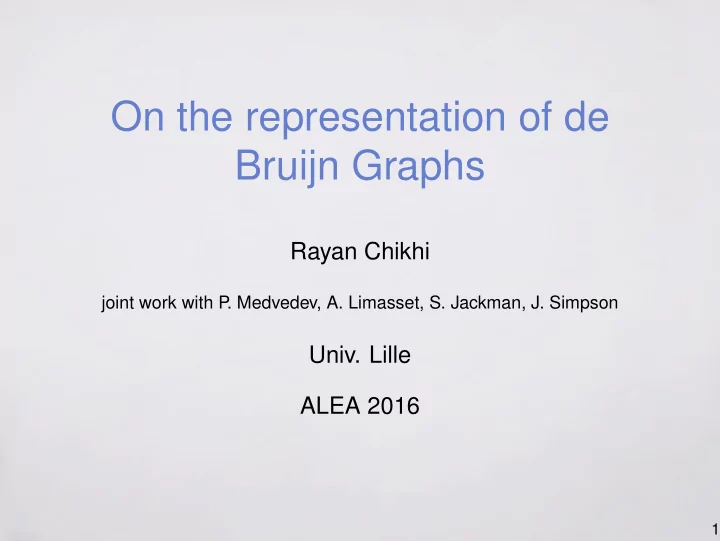

On the representation of de Bruijn Graphs Rayan Chikhi joint work with P . Medvedev, A. Limasset, S. Jackman, J. Simpson Univ. Lille ALEA 2016 1
de Bruijn Graph s❡q✉❡♥❝❡✿ ●❆❚❚❆❈❆❚❚❆❈❆❆ ❦✲♠❡rs✿ ●❆❚ ✭❦❂✸✮ ❆❚❚ ❚❚❆ ✳✳✳ Nodes: k -mers (words of length k ) Edges: exact suffix-prefix overlaps of length k − 1 CAT GAT ATT TTA TAC ACA CAA Usages: - Bioinformatics ◮ de novo assembly of sequencing data - Distributed applications 2
Genome sequencing 3
Genome assembly substrings from the genome, but position unknown 4
5
dBGs require a lot of memory 4300 512 Memory (GB) 244 14 Desktop Cluster Mammal Pine tree Bacterium computer node (20 Gbp) [Birol 13] 6
dBGs require a lot of memory 4300 512 Memory (GB) 244 14 Desktop Cluster Mammal Pine tree Bacterium computer node (20 Gbp) [Birol 13] Hash table Nodes TGA Additional GAT information: coverage, ATG GAT status, etc.. TGA ATG 6
How to encode the de Bruijn graph using as little space as possible? nodes only: { GAT , ATT , . . . } (human genome: k = 75, n = 3 · 10 9 k -mers) - Explicit list: 2 k · n bits 56 GB - Self-information of n nodes: [Conway, Bromage 11] �� 4 k �� log 2 bits n 44 GB 7
Recent techniques self-information (k=27) (k=27) XBW BF 0 4 8 16 22 bits/node - Bloom filter of nodes (w/ tricks) [Chikhi, Rizk 12], [Salikhov et al. 13] - XBW (Burrows-Wheeler for trees) variant [Bowe et al. 12] Why are they doing better? → different types of data structures 8
Data structures A membership data structure is a pair of algorithms ( const , contains _ node ) , where: data ← const ( G ) contains_node ( data , kmer ) returns { true, false } whether kmer ∈ G A navigational data structure is ( const , neighbors ) , where: data ← const ( G ) neighbors ( data , kmer ) returns the neighbors of kmer in G 9
Navigational data structures Membership NDS (e.g. hash table) Traverse dBG from known nodes � � Query membership of arbitrary nodes x � Enumerate nodes x � NDS has undefined behavior if query node not present. Recent techniques are NDS but not Membership DS 10
Why a NDS "beats" the self-information Consider this example NDS when k = 3 “For each node x = x 1 x 2 x 3 , out-neighbor: x 2 x 3 x 1 in-neighbor: x 3 x 1 x 2 ” Valid for these two graphs: AAT ATA TAA AAG AGA GAA So, 1 NDS ← → >1 dBGs 1 Membership DS ← → 1 dBG 11
Lower bounds We seek dBG representation lower bounds in the NDS model. self-information (k=27) (k=27) XBW BF 0 2 4 8 16 22 bits/node 12
NDS lower bound for linear graphs Linear graphs Theorem NDS for linear graphs need at least 2 bits/k-mer of space. Proof sketch: - Number of DNA strings that have n distinct k -mers and start with same k -mer: ≈ 2 2 n [Gagie 12] - Number of linear dBGs with n nodes and same left-most node: ≈ 2 2 n - Suppose NDS needs < 2 n bits, - Two graphs have the same NDS (pigeonhole principle) 13
NDS lower bound Theorem NDS need at least 3 . 24 bits/k-mer. Proof sketch: 1. Construct a large family of N graphs, such that for any two graphs, ∃ k-mer that appears in both graphs but with different neighbors. 2. Suppose NDS needs < log ( N ) bits 3. Two graphs have the same NDS (pigeonhole principle) , contradiction Our construction has N = 2 3 . 24 n 14
ATAA TAAA ATAC TAAC AATA ATAG TAAG ATAT TAAT ATCA TCTA ATCC AATC TCTC ATCG TCTG ATCT TCTT ATGA ATGC AATG ATGG ATGT ATTA ATTC AATT ATTG ATTT - Fix an even k ≥ 2, ℓ = k / 2, m = 4 ℓ − 1 - Consider a graph with ℓ + 1 levels of { A ℓ − i T α , α ∈ Σ i + ℓ − 1 } - Select m nodes per level � ℓ possible graphs � 4 m - m � ℓ ≥ 2 ( c − ǫ ) ℓ m with c = 8 − 3 log 3 ≈ 3 . 24 � 4 m - m 15
Conclusion / Perspectives Navigational data structures: - Model for recent dBG data struct. - Lower bound: 3 . 24 bits/ k -mer - Gap with known non-parameterized upper bounds (16) Open questions: - Closing the gap above - Entropy-compressed dBG representations Contact/references: - On the Representation of de Bruijn Graphs , 2014 - r❛②❛♥✳❝❤✐❦❤✐❅✉♥✐✈✲❧✐❧❧❡✶✳❢r - ❤tt♣✿✴✴r❛②❛♥✳❝❤✐❦❤✐✳♥❛♠❡ 16
Recommend
More recommend